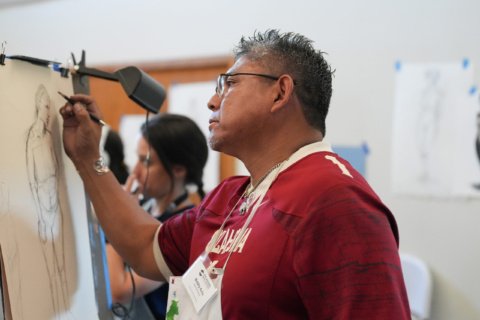With social and cultural problems increasingly complex, traditional research methodologies in humanities often fall short when used to capture the depth and nuance of human experience. Quantitative and narrative approaches, while rigorous, can sometimes overlook sensory, emotional and aesthetic dimensions crucial to understanding lived realities. In response, arts-based research (ABR) integrates creative practices, such as performance, visual art, poetry and digital media, into scholarly enquiry. This approach moves beyond data representation to foreground how feelings, creativity and imagination can illuminate hidden or marginalised perspectives.
A research project that examined the formation of Chinese fashion identity exemplifies this arts-based approach. In this collaborative project, my colleague and I, along with a group of nine undergraduate fashion design students, adopted cloth-making research methods to explore contemporary themes: these included collage, drawing, sampling and printing. The students then did costume-design workshops and digital-only design sessions, blending traditional craftsmanship with virtual construction in creative ways. These artistic processes themselves, which are documented in visual means, then became valuable data, revealing how individuals navigate heritage and the future.
Unlike conventional methods, this hands-on creative process provided more nuanced insights: the physical gestures involved in sewing and clipping, as well as expressive digital clothing design, illuminated the participants’ relationships with cultural narratives. Through these creative activities, the research uncovered the emotional layers of identity negotiation, prompting deeper reflection on modernisation and continuity in Chinese fashion.
To expand research through arts-based methods, researchers can thoughtfully integrate creative practices into methodological frameworks rather than substituting them entirely. For example, using collage or other forms of artistic expression alongside traditional interviews allows participants to articulate complex aspects of identity that may be difficult to express verbally. This approach enables researchers to interpret data through aesthetic and theoretical lenses, ultimately enriching analysis and deepening understanding.
Four ways to integrate arts-based methods in research
Researchers interested in applying arts-based methods might explore the following methodological strategies as starting points.
1. Use multimodal ways to collect data
Complement interviews with visual journalling, photography or soundscape creation to gather richer and more nuanced data, especially when focusing on sensory, embodied or experiential aspects. For example, my colleague and I curated a fashion show at a heritage site involving fashion design students to explore how they interpret cultural identity through clothing. During the process of making garments, we used photovoice methodology, allowing students to capture their lived experiences visually. These images were then discussed in interviews, revealing deeper meanings behind their creative choices. Multimodal material can be analysed for emotional tone, emergent themes or symbolic content, providing a more layered understanding than interviews alone.
2. Foster collaborative artistic creation
To foster equity and enhance shared authorship, actively engage participants at all research stages – design, data creation, analysis and dissemination – while explicitly documenting and crediting their contributions. In the fashion exhibition study, student participants helped plan the research design, curated exhibitions and co-authored creative outputs such as digital stories and performance pieces. Their interpretations, insights and rich narratives were shaped through the co-creation process with my colleague and me.
3. Reflect on and record the process
Consistent documentation of the research process is critical. Maintain detailed field notes, reflective journals and photographic records to capture iterative insights and challenges. This practice helps reveal the researchers’ learning and evolving analytic perspectives. Practical strategies include regular team reflections or collaborative analysis sessions – potentially including participants – where shifts in understanding and project directions can be openly discussed. In community arts research, for instance, audio-recorded reflections after workshops can serve as valuable analytic data alongside interviews.
4. Broaden public engagement
Use exhibitions, performances, digital storytelling or online galleries to extend dissemination beyond written reports. In the fashion show project, we incorporated audio clips into presentations, developed interactive infographics and hosted online photovoice exhibitions to engage broader audiences. We also worked closely with student participants to design dissemination strategies that made findings accessible and meaningful to their communities, fostering empowerment and wider social impact.
How to address barriers to arts-based research
Despite arts-based research’s methodological richness, practical constraints related to ethical review procedures, funding classifications and institutional conventions often privilege traditional evidence frameworks. These barriers can limit the visibility and legitimacy of ABR within academic and funding systems.
Researchers seeking to navigate these methodological and institutional challenges can:
1. Frame artistic practice as both method and data
Recognise that artistic practices – whether performing, making or composing – can serve simultaneously as the approach to enquiry (method) and as a source of research evidence (data). For example, collaborative sewing sessions with minority groups in cloth-making have functioned as both the site for group dialogue and the production of tactile artefacts. Methods such as visual arts, music-making, dance or performance can be integrated into research design, with the creative process itself documented as a central strand of knowledge production. Practices like arts workshops embody this dual role, where both the action and its outcomes (artefacts, performances) are analysed for insights.
2. Use transparent documentation, reflective analysis and critical evaluation for scholarly rigour
Maintain clear, thorough documentation at every research stage: field notes, video/audio recordings, reflective logs and process photography all contribute to transparency and reliability. Regular reflective analysis sessions (either individually or within a research team) enable researchers to surface underlying assumptions, account for positionality and critically interrogate methodological decisions. Engaging in critical evaluation – through peer feedback, public sharing of works-in-progress or systematically revisiting research questions – strengthens the scholarly rigour of ABR outcomes.
3. Show that creativity is a mode of enquiry, not just an ancillary tool
Demonstrate that creativity underpins the research process, guiding both the formulation of insightful questions and the development of innovative methods and interpretations. Creative practices are not simply aesthetic add-ons but are substantive, iterative forms of engagement with research problems. For example, arts workshops can generate forms of data and understanding that would be inaccessible through conventional methods.
Although some critics question the validity of artistic evidence due to its subjectivity, I would argue that the strength of ABR lies in its embrace of plurality and embodied knowledge. By valuing artistic forms of truth-telling, researchers can broaden the scope of scholarship in an increasingly complex society.
4. Connect research with contemporary questions
Publishing research using arts-based methods remains challenging, as many leading journals in the humanities and social sciences are often hesitant to send such work out for review, and may even reject submissions without review. Based on my experience, a helpful strategy is to connect your research with current scholarly conversations and clearly conceptualise the insights from practice-led work.
How arts-based research merges technology, artistry and scholarship
The challenge for researchers in taking up arts-based research methods lies in the academic system’s tendency to privilege rational, textual or analytic forms of knowing over expressive, affective and embodied ones. Arts-based methods offer fresh epistemological tools and inclusive ways of engaging participants and audiences that disrupt this hierarchy. What is compelling about this methodological shift is its power to bridge disciplines, democratise research participation and render knowledge both intellectually and sensorially engaging.
Arts-based research repositions creativity at the heart of enquiry, challenging conventions about objectivity, evidence and communication. It invites scholars to engage in research as a relational, affective and imaginative act, where knowing emerges through making. When applied thoughtfully in educational and cultural contexts, this methodology transforms not only data collection and representation but the very experience of learning and knowledge production.
Peng Liu is an associate professor in the Faculty of Humanity and Arts at Macau University of Science and Technology.


